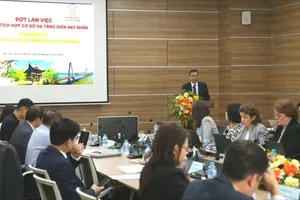 |
Children are using smart devices to access the Internet (Photo: SGGP) |
In June 2023, the Ministry of Information and Communications issued a permit of a MVNO for FPT Retail. Being a large technological distribution channel and owning a strong digital ecosystem, this company is expected to attract a huge number of customers.
Before FPT Retail, other MVNOs appeared in Vietnam, including iTel (member of Dong Duong Telecom JSC. with the prefix number of 087), Wintel (member of Masan Group, prefix number 055), Local (member of Asim Telecom JSC., prefix number 089), VNSKY (member of the VNPAY ecosystem, prefix number 0777).
VNSKY’s Director Nguyen Van Dung said that with the bloom of integrated platforms for online education, entertainment, and business, the first SIM card for traditional telecoms services cannot satisfy current demands on mobile data use of consumers. VNSKY provides the second one with large data packages for extremely reasonable prices for the public.
At present, the cheapest data package from a domestic MVNO is the ‘Data 6GB’ by VNSKY, at VND27,500 (US$1.14). It includes 6GB of hi-speed data, 1,000 minutes of calls within the VNSKY and MobiFone networks, 50 minutes of calls to other networks. Compared to that, the cheapest package in a ‘traditional’ network is ‘ST5K’ by Viettel at VND5,000 ($0.21), with 500MG of hi-speed data, 50 minutes of calls within the Viettel network. This is obviously not as economical.
Statistics from the Ministry of Information and Communications show that there are now about 130 million mobile subscribers in Vietnam, 95 percent of which belong to the three major carriers of Viettel, VinaPhone, and MobiFone. MVNOs own 2.6 million subscribers, accounting for 2 percent.
Thanks to the investments of giant businesses, the MVNO model in Vietnam is formed. Such brand names as iTel of Bitexco, Wintel of Masan, and VNSKY of VNPAY are seeing impressive growths.
After 3 years, iTel owns 1 million subscribers, earning a profit of billions of VND. In the first quarter of 2023, Wintel obtained 122,000 new subscribers, with a revenue of VND16.48 billion ($684,000). VNSKY aims at having 5 million customers by 2025 to be one of the largest MVNOs in Vietnam.
Not a new concept, MVNOs in Vietnam still possess a rather humble quantity of customers with limited services. To boost its growth and competitiveness against traditional networks, telecoms experts suggest that these operators should develop Internet-based services that truly benefit users in the fields of finance, education, commerce and have not been provided by giant network carriers now.
Deputy Director Nguyen Phong Nha of the Telecommunications Authority (under the Information and Communications Ministry) said that the Average Revenue Per User in the domestic mobile market is rather low, not to mention the fierce competition from Over-the-Top (OTT) services. The participation of MVNOs is expected to diversify service types for the digital transformation process in the aspects of finance, education, healthcare, and entertainment.
“When amending the Telecoms Law, policy makers consider the content of wholesaling data packages to create a legal corridor for more convenient negotiation among network carriers to purchase data and provide services with reasonable prices”, said the Deputy Director.
























